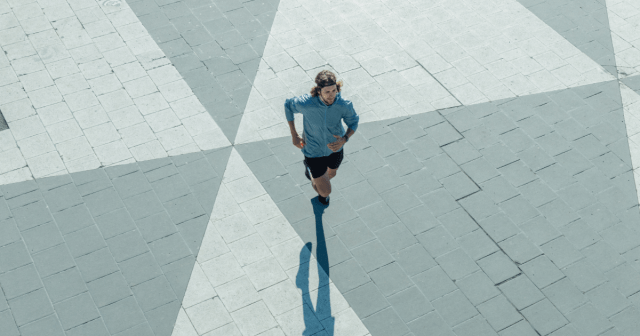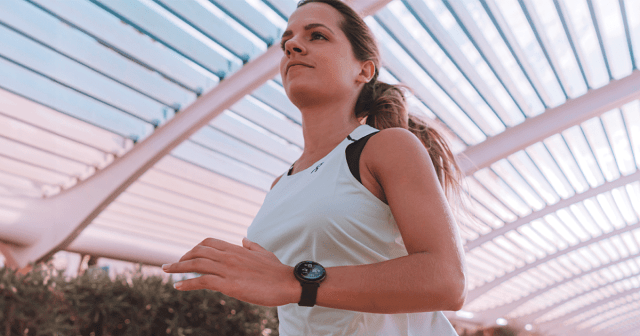What happens when a longtime runner and avid marathoner is suddenly sidelined? Some athletes on the injured list are happy to jump on a stationary bike or ride outside, while others opt for pool running, Pilates, or a high-speed spin on the ElliptiGO. But when a particularly bad Crohn’s disease flare took runner Alison Feller, host of the Ali on the Run Show podcast, out of the game, she discovered a new way to sweat: power walking. Here’s her story.
I’ve had Crohn’s disease since I was 7 years old. But in spite of the disease and its many, many challenges – I’ll spare you all the details, but think lots of stomach cramping, pain, urgent bathroom runs, and debilitating joint pain – I somehow became a runner.
I started running after college, when I moved to New York City and learned that you could get wine until 4 AM and pizza ’round the clock. I was on a 22-year-old writer’s salary, and running seemed like the cheapest, most convenient option, which is the short version of how this former dancer became a marathoner.
My very first run lasted exactly 2.5 city blocks – that’s not even a quarter-mile – and since I had no clue about pacing, I just went all-out for about 30 seconds and then stopped, gasped for air, and walked home. That first run took less time than it takes to brush my teeth or wash my hands, but I admittedly felt that runner’s high. I signed up for a four-mile race, and the day I finished that race, signed up for my first half-marathon.
The shock of not being able to run
I’ve since completed countless road races, including seven marathons. Running has become my identity (hence the blog, Ali on the Run, and the Ali on the Run Show podcast), so when my Crohn’s disease flares, which it does every so often, and I can’t run, it feels like being stripped of my identity. The pain, the bathroom stuff, the sleepless nights – that’s all tough. But not being able to run as a means to cope with it all? That makes it so much worse.
I’d love to say I’m fresh off a fall racing season and am now equipped with a new set of personal records, but the less triumphant reality is that my Crohn’s has been flaring for the better part of the past year and a half. I always try to run through my flares for as long as I can, but eventually the pain and urgency take over, and I can’t do it anymore. So when that happened this time around – right when I was training for the 2016 New York City Marathon and was definitely in the best shape of my life – I was sad and angry.
There was nothing I wanted to throw into my routine to replace running. Cycling is fun every now and then, but I wanted to find something that was low impact and wouldn’t further upset my stomach, and that I could do inside on bad days (so I’d always be near a bathroom!) or outside when I was up for it.
And that’s when I discovered power walking. Now before you let out a laugh thinking power walking is the equivalent of binge-watching Scandal or walking to get the mail, let me assure you, it’s so not.
How I discovered power walking
I first discovered the art of power walking when I started taking classes at Orangetheory Fitness. Half the class is spent on the treadmill, and there are three general categories of OTF-goers: runners, joggers, and power walkers. Naturally I wanted to be a runner – someone who can comfortably run at a 10-minute per mile pace for 20 minutes or longer – but it wasn’t in the cards at the time. So I sucked up my pride, lowered my speed from 6.5 mph to a far more tolerable 3.5 mph, and got started.
Within five minutes, I was working at 84 percent of my maximum heart rate. Five minutes later, I was soaked in sweat. By the time the instructor told us to move onto the floor for the next part of the class, I felt a glimmer of that runner’s high I used to have for breakfast every morning. And the next day? Well, the next day I was sore from cranking up the inclines on the treadmill.
Turns out, power walking can be a pretty awesome workout, both on the treadmill and outside.
power walking comes with benefits similar to running
Turns out, power walking can be a pretty awesome workout, both on the treadmill and outside. I love that power walking outside is, in fact, pretty similar to running. You may not cover quite as much ground in the same amount of time, but you still get to be outside, log a decent workout, and, should you choose to let friends tag along, be social. When I’m up to it – and not just running from one bathroom to the next – I love running with friends. But I’m usually struggling to carry on a conversation, either because it’s Track Tuesday and we’re busting out 400m repeats (so not ideal for catching up on aforementioned episodes of Scandal!) or because we’re hauling up hills which, even at the most “conversational” pace, still leave me breathless and unable to converse.
I’m by no means an Olympic racewalker here. (Yes, racewalking is an Olympic sport, and before you scoff at the idea, reconsider: The world’s top racewalkers are hustling between a 7- and 8-minute per mile pace – faster than many people sprint!) But even on my healthy days now, I still keep power walking in my weekly workout routine. I love that it’s a different way to challenge myself, and the fact that it’s a low-impact option keeps my stomach happy.
Beyond the fact that it’s actually pretty enjoyable, power walking comes equipped with loads of health benefits, many of which are similar to running.
Beyond the fact that it’s actually pretty enjoyable, power walking comes equipped with loads of health benefits, many of which are similar to running. Power walking can burn 300–600 calories an hour (pick up the pace and head uphill for maximum burn), and power walking may help lower LDL (or “bad”) cholesterol levels, according to the University of Maryland Medical Center. Research also suggests that every hour you spend walking may add up to two hours to your life, and that it can help reduce risk of heart disease, stroke, type 2 diabetes, cancer, and depression.
So the next time you’re meeting your friends for a run, I dare you: Make it a walking date instead.
In the spotlight

Alison Feller
If you liked this post, don’t forget to share so that others can find it, too.
Please note that the information provided in the Polar Blog articles cannot replace individual advice from health professionals. Please consult your physician before starting a new fitness program.




